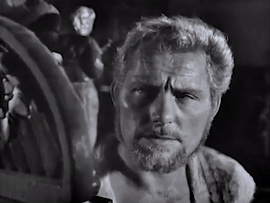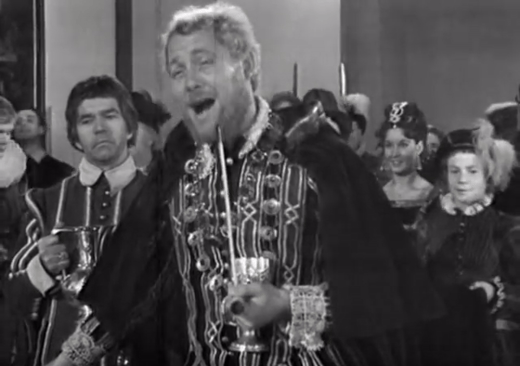
.com

Estd. 2020
Approved by the Shaw Family



Hamlet at
Elsinore



"It smells to Heaven. It hath the primal eldest curse upon 't,
A brother's murder."

“I still don’t think of myself as a star, success lasts only three seconds. After that you’re the same as you were before you had it. I’m not a true artist anyway because I refuse to shrug off my family."



Robert Shaw as
King Claudius of Denmark

The ghost of the King of Denmark tells his son Hamlet to avenge his murder by killing the new king, Hamlet's uncle. Hamlet feigns madness, contemplates life and death, and seeks revenge. His uncle, fearing for his life, also devises plots to kill Hamlet.
Directed by Phillip Saville
From the play by William Shakespeare
Produced by Peter Luke for BBC Television and Danmark Radio
Costumes: Olive Harris
Make-up: Christine Hillcoat
Fights: William Hobbs
Lighting: Robert Wright
Decor: Poul Arnt Thomsen
Music: Richard Rodney Bennett
Conductor: John Hollingsworth
Technical operations director: Ole Dreyer
CAST
Horatio: Michael Caine
Marcellus: Peter Prowse
Barnado: Michael Goldie
Laertes: Dyson Lovell
Polonius: Alec Clunes
Gertrude: June Tobin
Hamlet: Christopher Plummer
Ophelia: Jo Maxwell Muller
Gertrude: June Tobin
Rosencranz: David Calderisi
Guildenstern: Bill Wallis
Player King: David Swift
Player Queen: Lindsay Kemp
Prologue: Willlam Hobbs
Lucianus: Steven Berkoff
Fortinbras: Donald Sutherland
Captain: Joby Blanshard
Grave-digger: Roy Kinnear
Priest: Charles Carson
Osric: Philip Locke
Transmission Date: Sunday 19th April 1964
TX: 8.05pm
Location(s): Elsinore Castle, Denmark








gallery
Hamlet at
Elsinore


Hamlet at
Elsinore
The Battlements
Christopher Plummer Interview
Behind the scenes footage
the late Christopher Plummer and some other famous actors discuss the difficulty of playing Hamlet.
Very rare super 8mm footage shot on location in Denamrk featuring Robert as King Claudius.


Hamlet at
Elsinore
Promotional Material


Christopher
Plummer
(1929 - 2021)

Michael
Caine
(1933 - )

June
Tobin
(1926 - 2015)




Roy
Kinnear
(1934 - 1988)
Donald
Sutherland
(1935 - 2024)
Alec
Clunes
(1912 - 1970)
Jo Maxwell
Muller
(1944 - 2010)


This is Shaw's finest hour on television as he gives a truly superb masterclass in Shakesperian acting as King Claudius of Denmark. Richard Dreyfuss would often say that this was his favourite performance of Shaw's.
This is an outstanding presentation of the story and very daring for the time as it was filmed entirely on location at Elsinore Castle. Boasting an excellent cast, this would be the first of many times Shaw would work with Plummer (who incidentally is magnificent in the central role), director Philip Saville uses the Danish location to the max and keeps the story moving along at a thundering pace.
Shaw's tortured monologues are a joy to behold as he commands the screen with a brooding presence topped off with the bleached blonde hair he had in From Russia with Love. The climatic ending is handled beautifully and Michael Caine and Jo Maxwell-Muller turn in fabulous supporting performances.
This truly is a landmark adaptation and showcases what a formidable talent Shaw was when it came to the classics.

Hamlet at Elsinore is a 1964 television version of the c. 1600 play by William Shakespeare. Produced by the BBC in association with Danish Radio, it was shown in the U.S. on NET. Winning wide acclaim both for its performances and for being shot entirely at Helsingør (Elsinore in English), in the castle in which the play is set, it is the only version (with sound) of the play to have actually been shot at Elsinore Castle.
This programme was recorded and edited on video tape (2" quadruplex) and not 'filmed'. The director was Philip Saville. It was the longest version of the play telecast in one evening up to that time, running nearly three hours. A 1947 telecast of the play had split it up into two ninety-minute halves over two weeks.
The Canadian actor Christopher Plummer took the lead role as Hamlet and earned an Emmy Award nomination for his performance. In supporting roles were Robert Shaw as Claudius, Donald Sutherland as Fortinbras, Roy Kinnear as the Gravedigger and Michael Caine, in his only Shakespearean performance, as Horatio. Sutherland, Caine and Shaw were, at the time, almost completely unknown to American audiences, and just before the presentation's first U.S. telecast, Plummer began to gain popularity in the U.S. because of his appearance in the 1965 musical film The Sound of Music.
One of the most significant of all television Shakespeare productions on television was produced nearly fifty years ago as a contribution to the quatercentenary celebrations of the playwright’s birth. The idea for a television version of Hamlet recorded on location at the castle where the events are set originally came from Danmarks Radio. The project became one of the earliest major European co-productions and was pioneering in its exclusive use of outside broadcast cameras to record a drama. It also resulted in a distinguished adaptation that is engaging, insightful and often thrilling.
There was, however, a tradition of companies playing Hamlet at Kronborg Castle, a Renaissance palace built rather later than the medieval king Amleth whose legend was one of Shakespeare’s sources. Denmark’s Royal Theatre from Copenhagen staged a spectacular production there in 1916. Visiting troupes from Britain included the Old Vice Company with whom Laurence Olivier performed the lead role in 1937, while Michael Redgrave was the prince when the same group returned in the summer of 1950. The Old Vic Company went again in 1954, this time with Richard Burton.
Under the terms of the broadcast co-production arrangement BBC Television provided most of the fifty-strong creative team, including director Philip Saville and producer Peter Luke together with the cast, while the Danes contributed the magnificent location, 230 soldiers as extras and two outside broadcast units staffed by forty engineers.
Almost all drama at the time was shot with multiple cameras in television studios, but Saville extended the techniques of this form by taking to the castle units that were usually deployed for state occasions and sports events. Two-inch ‘quad’ videotape was used for the recording, and this contributes both the vivid immediacy of many sequences but also the ‘streaking’ across the images, especially during the nighttime scenes.
The twelve days of rehearsals and shooting were plagued with problems, including persistent rain and fog, as well as the regular blasts of the Elsinore foghorn. Saville quickly learned how to shoot 24-second takes that nestled into warning signal’s regular periods of silence. There were times too when Saville was deploying ten cameras for a scene, although some of the most effective parts of the drama, such as the fractured sequence of locations for ‘To be or not to be’, are shot with just one or two cameras.
Sydney Newman, Head of BBC Television’s Drama Group at the time, described Hamlet at Elsinore as ‘the most wonderful, complicated and exactly production ever done for television’. Including the special cable that was needed to run electricity from the nearby town, the total budget was announced as £40,000, of which the BBC contributed £25,000.
Christopher Plummer makes a fine Prince, but tucked away in a production file in BBC Written Archives at Caversham is a cable recording an even more intriguing casting idea. The brief message to the Artists Booking Department at BBC Television reads, ‘Previous commitments prevent my accepting your kind offer. Thank you for thinking of me.’ It is signed, ‘Sincerely, Marlon Brando’.
Plummer was cast largely on the strength of his theatre work at Stratford, Ontario, where he had taken the role seven years before. He apparently insisted that the 18 year old Jo Maxwell Muller be cast at Ophelia, and other major roles went to Donald Sutherland, Michael Caine and Robert Shaw, none of whom was nearly as well-known as later film careers would make them.

























































